The history of Germany is very rich not only in terms of different events, but also in their number and antiquity. Due to its history Germany has a very diverse reputation worldwide. However, it is difficult to deny certain cultural, technical, scientific and even sporting achievements of this country. As a result, it is not easy to characterize the entire country that is constantly changing in the course of its history. But one of its aspects we can characterize quite well. Today, this aspect will be the cultural and aesthetic component of the German states — their flags and coat of arms.
Germany is a federation which has thirteen states and three city-states which are equal in status and land rights. Let’s take a closer look at the flags and coat of arms of the major German states.
Symbols of Bavaria
Bavaria’s coat of arms was borrowed from the Counts of Bogen who lived before 1242; the coat of arms was later passed to the Wittelsbach family and then became a symbol of the whole Bavaria. On the shield of the modern coat of arms one can see four emblems, each of which represents one of the Bavarian territories: the Golden Lion — Palatinate, the “Franconian Rake” — Franconia, the Blue “Pantier” — Lower and Upper Bavaria, and the three black lions — Swabia. The coat of arms is held by two golden lions and in the center of the shield there is a small coat of arms of Bavaria in the traditional colors of this state.
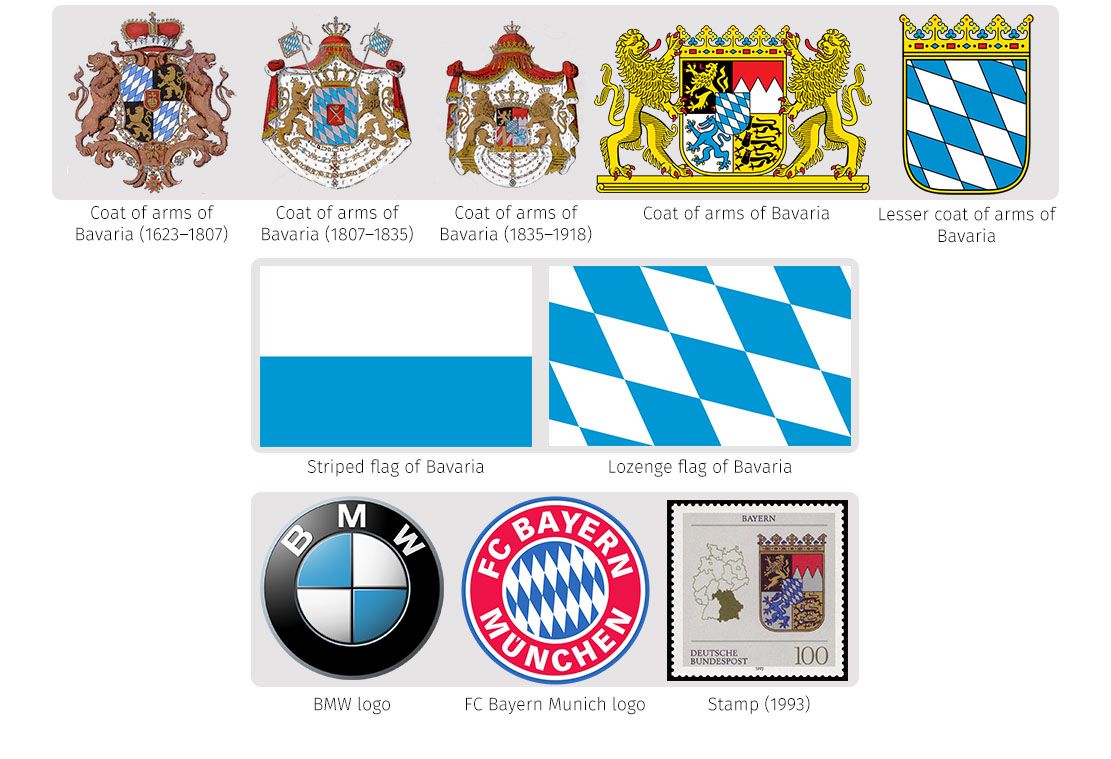
Symbols of Bavaria
Bavaria technically has two official flags which were adopted at the same time and are both used in the state. However, the lozenge-style flag is of course more memorable and unique than its bicolor brother.
As shown in the picture, the flag is used in the logo of the local football club Bayern Munich, and the same motifs were used in the club’s emblem almost since its inception. Another logo that is based on the flag and the coat of arms of Bavaria is the logo of BMW, a well-known car brand.
Symbols of Baden-Württemberg
The golden coat of arms of Baden-Württemberg was officially recognized in 1954. In addition to the three leopard lions, the crown is decorated with the lesser coat of arms of the state’s territories.

Lesser coat of arms on the crown of the Baden-Württemberg coat of arms
The flag of the state was adopted at the same time as the coat of arms, that is, after the union of the Baden, Württemberg-Baden and Württemberg-Hohenzollern regions. The colors of the flags respectively: yellow-red-yellow in Baden, black-red-yellow in Württemberg-Baden and black-red in Württemberg-Hohenzollern. The current flag of Baden-Württemberg originated from them.
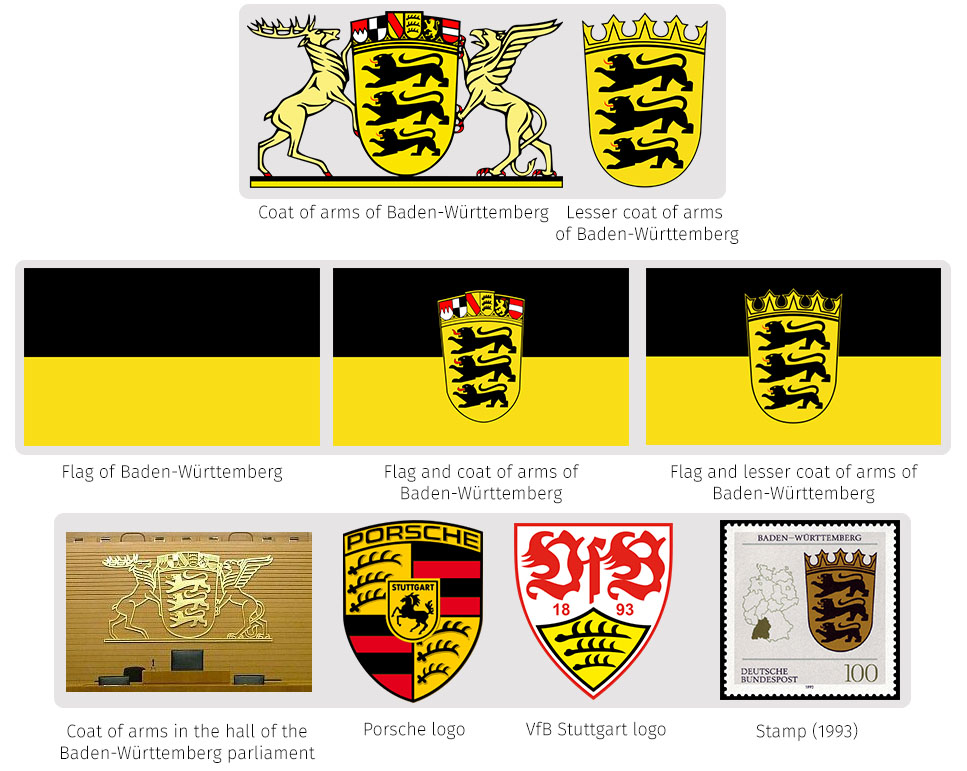
Symbols of Baden-Württemberg
A concept of the coat of arms of Württemberg is used in the logo of the VfB Stuttgart football club, namely: the antlers of black and yellow colors. Colors, antlers of Württemberg and the Stuttgart Steed are also used in the Porsche logo.
Symbols of Brandenburg
Brandenburg’s coat of arms was adopted only in 1990, but the red eagle on it is much older — this symbol is known from the X century. This symbol was passed to the Prussian province of Brandenburg and then to the current German state.
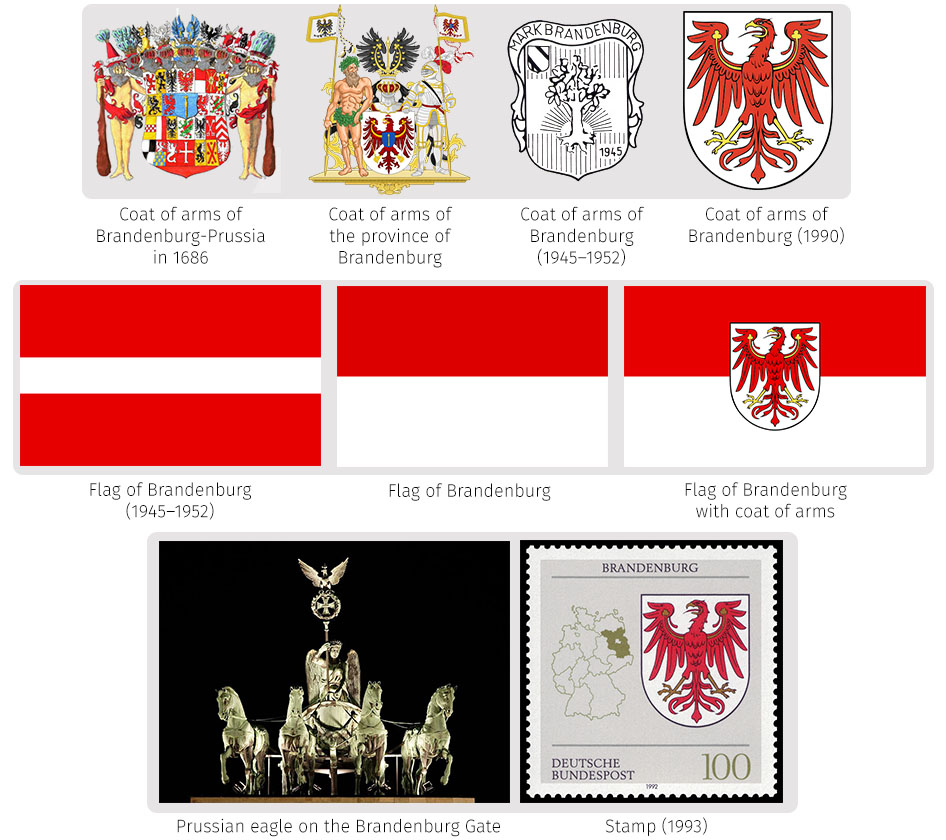
Symbols of Brandenburg
The red and white flag of Brandenburg has also been used since the days of the Free State of Prussia. A similar symbol is used on the Brandenburg Gate — the Prussian eagle.
Hesse Symbols
Hesse coat of arms was introduced in 1949. It is based on the historical coat of arms of Ludovingians, the Landgraves that ruled the Hesse and Thuringia lands and were known from the XI century. Therefore, it can be stated that the coat of arms of these territories have a fairly long history. One of the first mentions of the emblems can be found in the Ingeram Codex armorial (“Der Ingeram-Codex”) made in 1459. On the azure background of the shield a heraldic lion is depicted consisting of silver and red stripes. The “People’s crown” on the coat of arms is in the form of vine leaves.
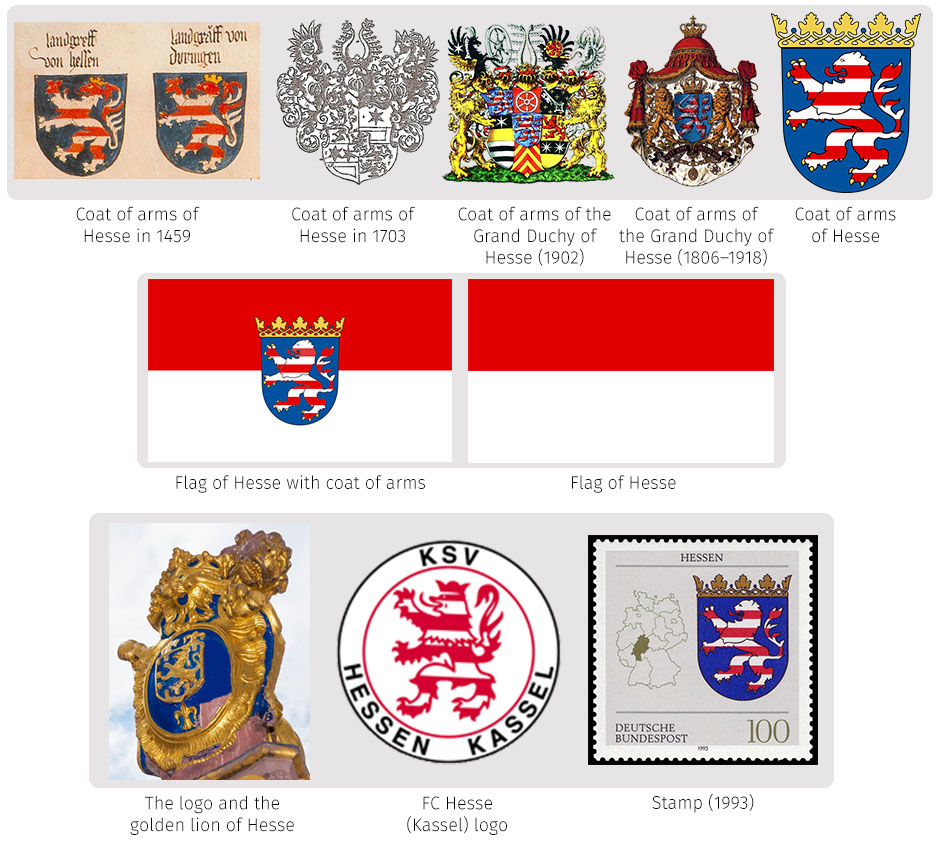
Hesse symbols
The same red-white flag is used by Hesse. In general, the red and white color is a quite popular combination in Europe: starting from the historical regions of Spain and ending with the traditional colors of the Belarusian people. The adoption time of the flag corresponds with the adoption of the coat of arms.
Hesse-Cassel football club that plays in the fourth southwestern German league also uses the Hesse striped lion as its symbol. Also, there is a golden lion in the capital of Hesse — Wiesbaden.
Symbols of Mecklenburg — Western Pomerania
Coat of arms of Mecklenburg — Western Pomerania is composed of three different coat of arms of three smaller territories. First of all it is the impressive bull of Mecklenburg which already looks great on its own. However, symbols of Brandenburg and Pomerania have been added to the coat of arms — the red eagle and griffin respectively. The emblem was adopted in 1990, but the coat of arms of the presented smaller territories are older than the mentioned date.
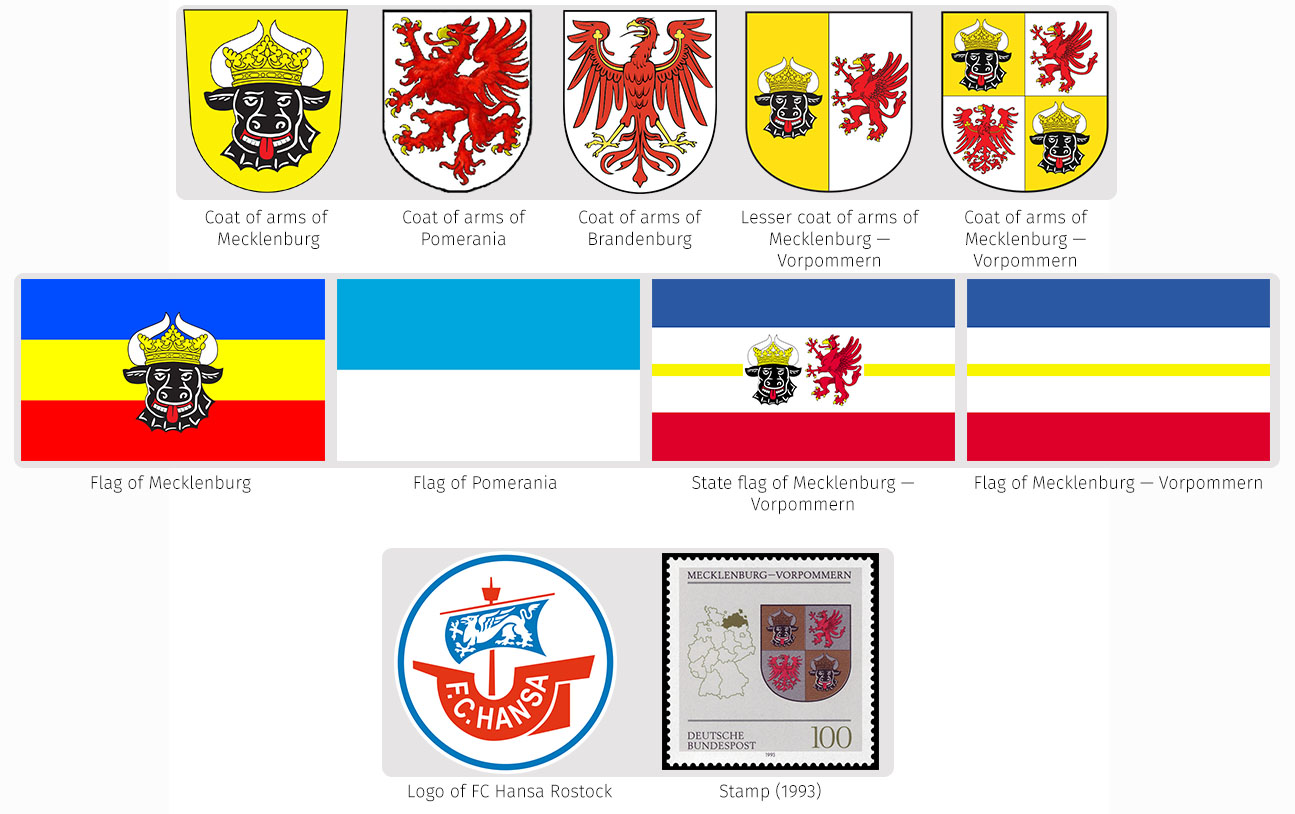
Symbols of Mecklenburg — Western Pomerania
Ultramarine-blue-red flag with a yellow stripe in the middle most likely originated from the mix of Mecklenburg and Pomerania flags. Flag of Pomerania, for example, was already used around 1882. The bull of Mecklenburg and Pomeranian griffin are sometimes added to the flag.
One of the most renowned clubs in Eastern Germany that plays in the third German Bundesliga — Hansa Rostock uses on its emblem an image of the Pomeranian griffin that is also used on the flag and the coat of arms of the Rostock city.
Symbols of Lower Saxony
The coat of arms of Lower Saxony since ancient times uses the “Saxon Steed”. A black horse on a yellow background was initially the coat of arms of Widukind, the last king of the Old Saxony. Also, this flag was the first known Saxon flag. But with the conversion to Christianity the colors of the coat of arms were changed. In its modern design the coat of arms was adopted in 1952.
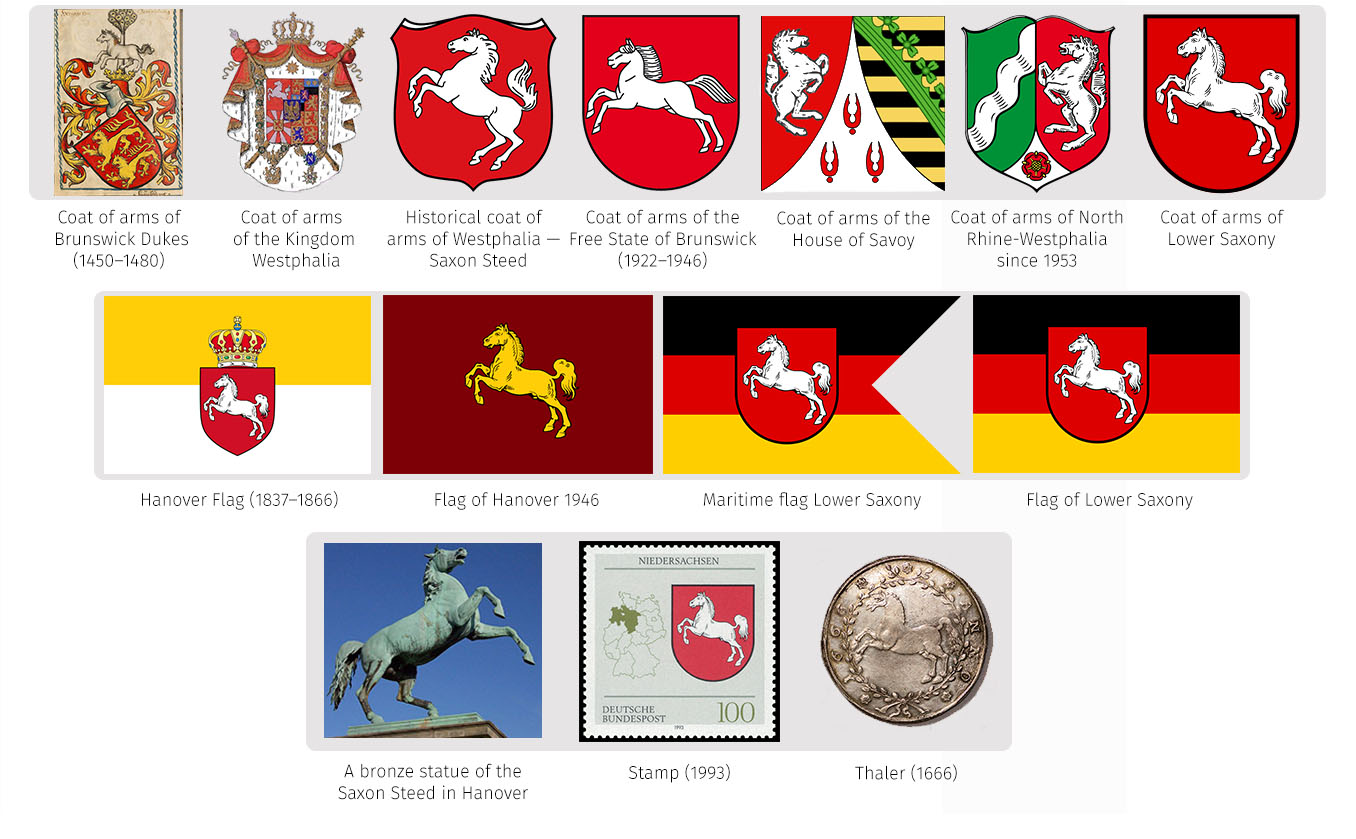
Symbols of Lower Saxony
The flag was adopted at about the same period as the coat of arms. The flag uses traditional for Germany colors. A thaler of the 1666 year found in Braunschweig proves the antiqueness of Saxon Steed.
Symbols of Rhineland-Palatinate
The coat of arms of Rhineland-Palatinate was created in 1947 during the formation of the land. It consists of three coat of arms: the red cross represents the Electorate of Trier, the Wheel of Mainz represents the Electorate of Mainz and the golden lion represents the County Palatinate of the Rhine.
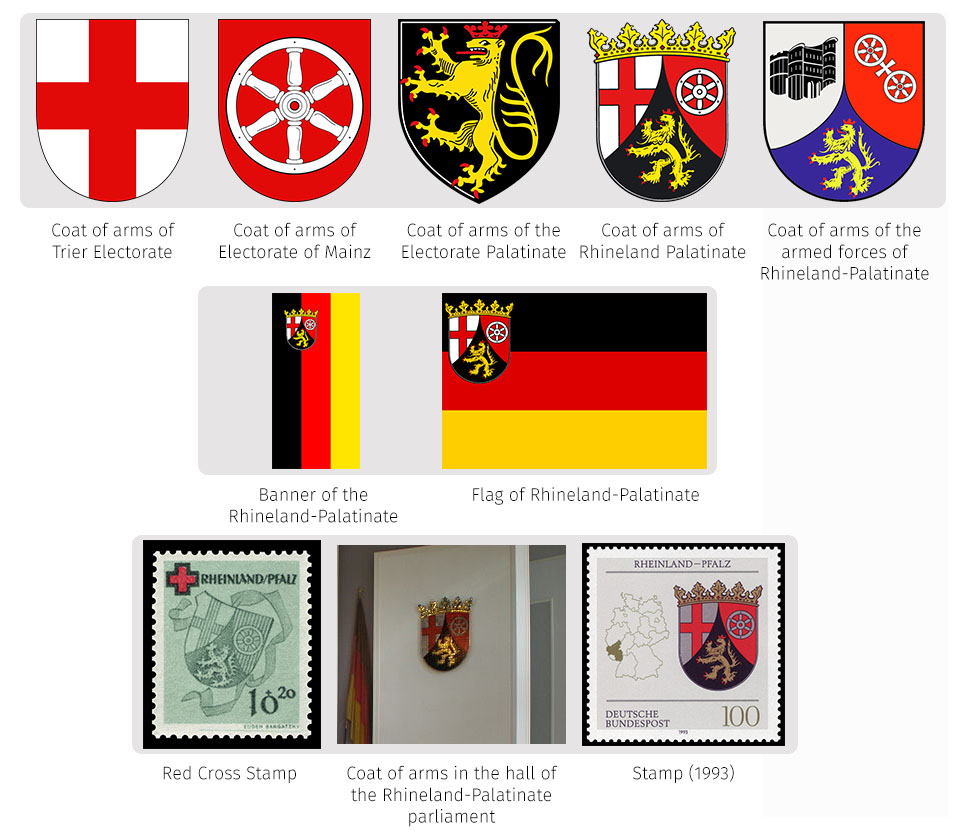
Symbols of Rhineland-Palatinate
Traditional German colors are used in the flag. The canton on the flag is the coat of arms of the state. The vertical banner can be seen on Rhineland-Palatinate buildings.
Symbols of the North Rhine-Westphalia
Coat of arms of the North Rhine-Westphalia was adopted in 1948. The coat of arms originates from the coat of arms of the Rhine Province on which a bend wavy is showed as well as a horse — the symbol of Westphalia. A heraldic rose of Lippe is present at the coat of arms. The Lippe family has roots since the X century whose house was named in honor of a river of the same name in Westphalia. Beatrix, the Queen of the Netherlands from 1980 to 2013, belongs to this house on her father’s side.
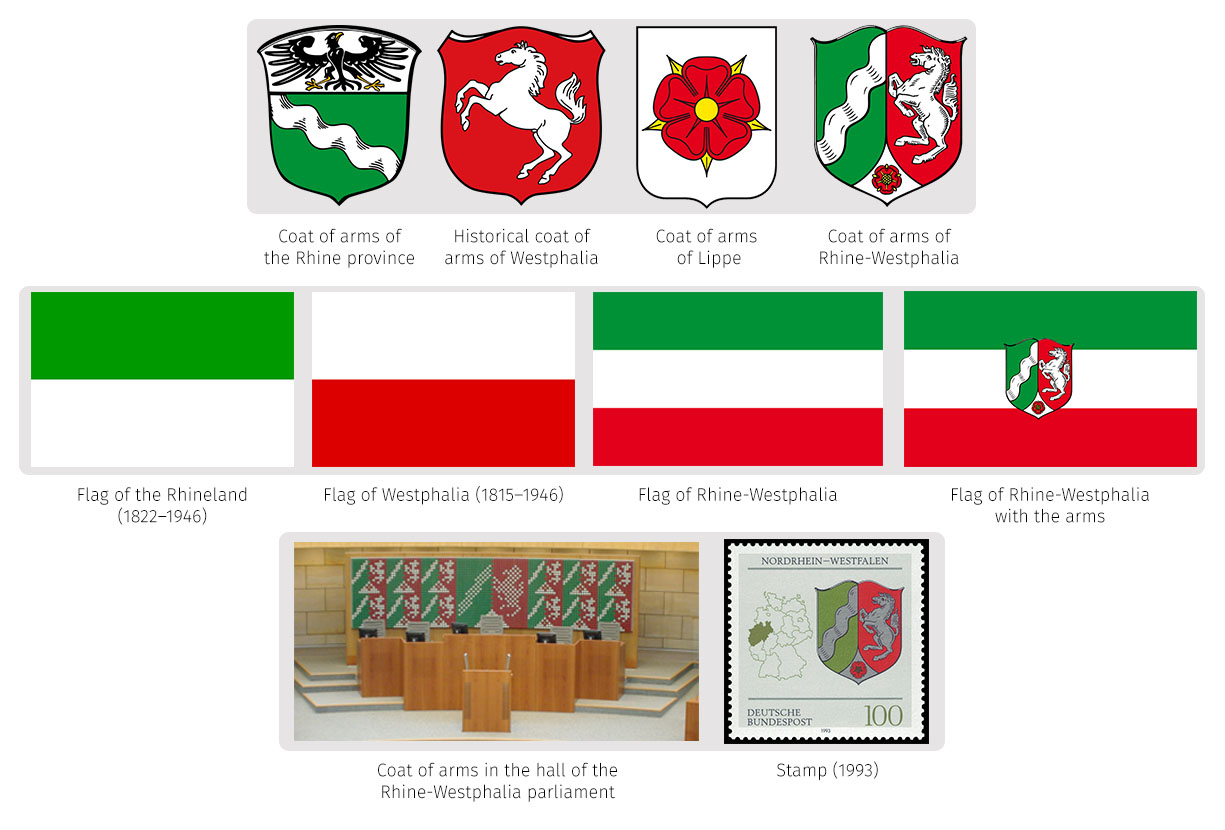
Symbols of the North Rhine-Westphalia
Red, white and green colors are official for this land. Green for the Rhineland — the southwest part of the North Rhine-Westphalia, red for Westphalia-Lippe — the northeastern part, respectively.
The flag of the North Rhine-Westphalia is used since 1948 and it was later formally adopted. The colors originate from the two older flags of the Rhine Province: green and white horizontal bicolor and the flag of Westphalia — white and red horizontal bicolor.
Symbols of Saarland
The coat of arms of Saarland consists of four separate coat of arms — a situation similar to other states. A silver lion with crosses — the Saarbrücken county, the red cross — the diocese of Trier, three silver alerions on a red bend — the duchy of Lorraine and a yellow lion — the Electorate of the Palatinate.
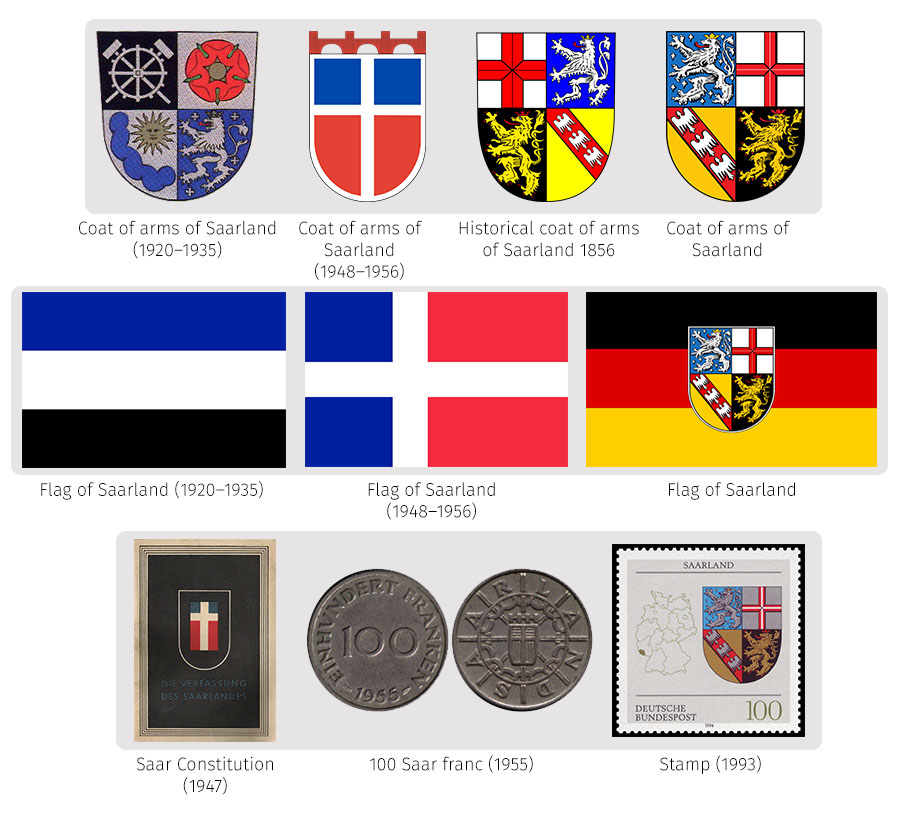
Symbols of Saarland
The flag of Saarland is based on the flag of Germany with the coat of arms of Saarland. A blue-white-black tricolor was also used and a flag with the Scandinavian cross and the colors of the French flag due to the fact that Saarland was under the protectorate of France.
Symbols of Saxony
The coat of arms of Saxony is used since 1700. It has black and yellow stripes and a band in form of a green crown. The coat of arms was previously used by the House of Ascania. The colors of the flag of Saxony were adopted in 1815, although even earlier mentions of the flag of this territory can be seen in the history of Saxony — in the Ascania and Wettin families. Nevertheless, today the official colors of the state are white and green.
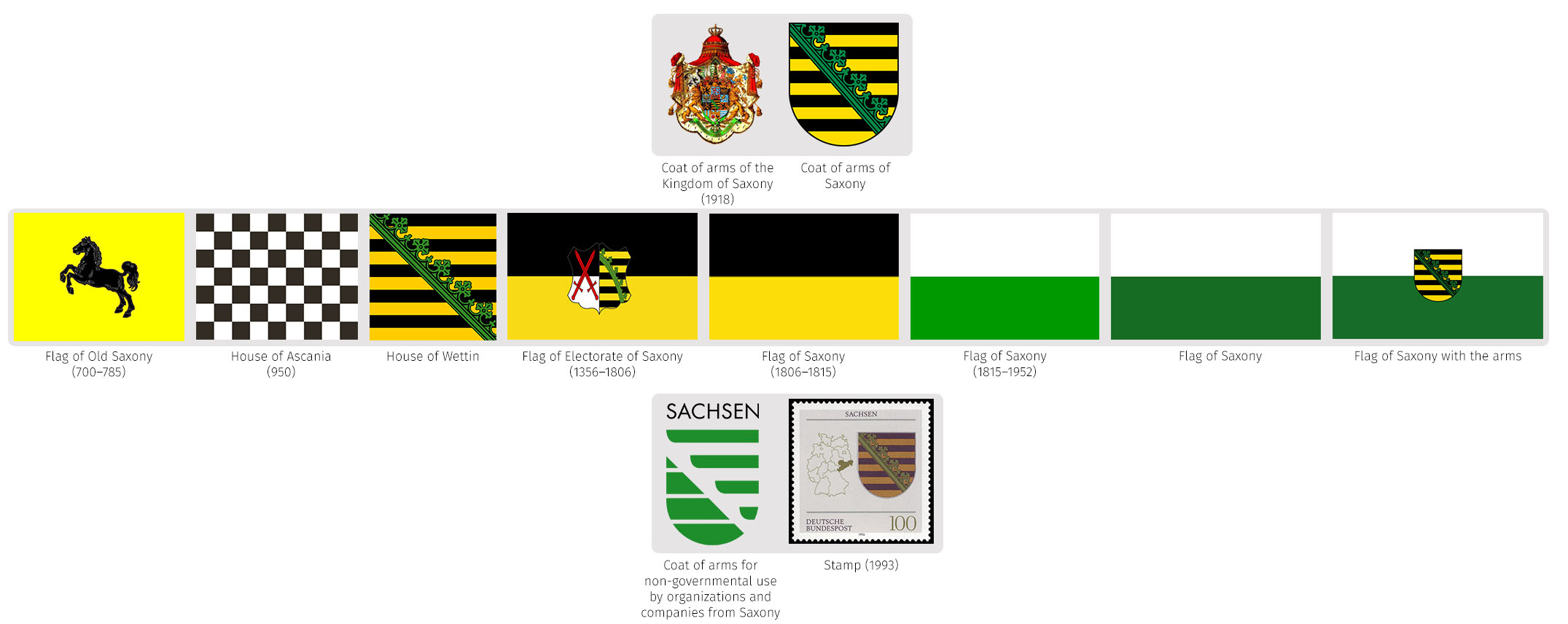
Symbols of Saxony
Symbols of Saxony-Anhalt
The coat of arms of Saxony-Anhalt has similar features with Saxony. For example: black and yellow stripes and the green crown at the same angle. The bear was taken from the coat of arms of Anhalt.
The colors of the modern flag of Saxony-Anhalt originated from the historical flag of Saxony and are its reverse.
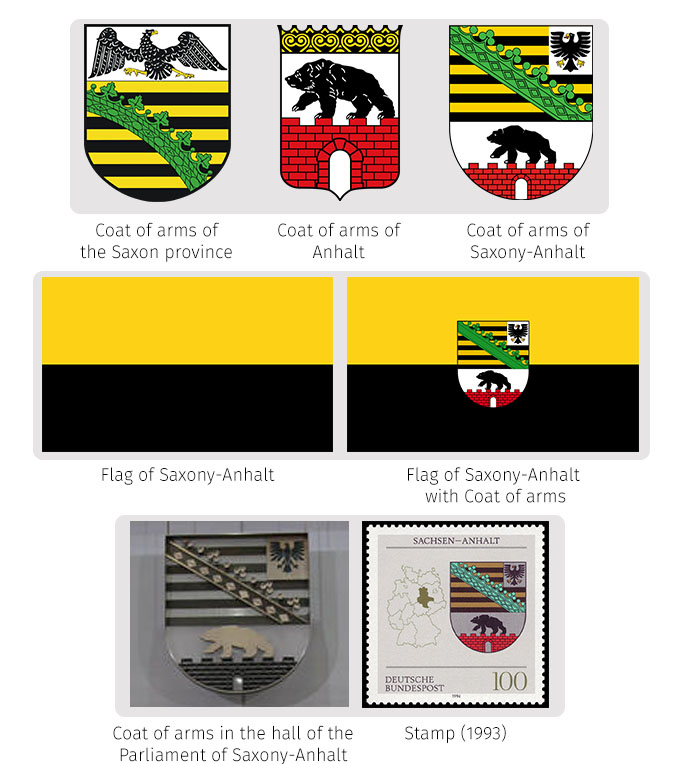
Symbols of Saxony-Anhalt
In order to be different from the Baden-Württemberg flag the colors were reversed. The flag was recognized in 1991.
Symbols of Thuringia
The coat of arms of the state is somewhat similar to that of Hesse. This is due to their common origin from a red-white striped lion of the Ludovingians family, which is known from the XI century. The coat of arms uses as many stripes as the Ludovingians use — eight. The lion is depicted on an azure shield.

Symbols of Thuringia
Thuringia flag is very similar to the flag of Poland, though the red color is slightly different. The colors of the flag have been known since 1921 and the flag itself is a reverse of the flag of Hesse. There is also a statue of a lion in Thuringia.
Symbols of Schleswig-Holstein
We can observe two images on the two-sided coat of arms of Schleswig-Holstein. The first part of the shield (called “dexter”) displays two leopard lions; the Schleswig lions are taken from the coat of arms of Denmark. The right part of the shield (“sinister”) displays a nettle leaf of Holstein — an ancient symbol that was used by the Counts of Shauenburg and Holstein.
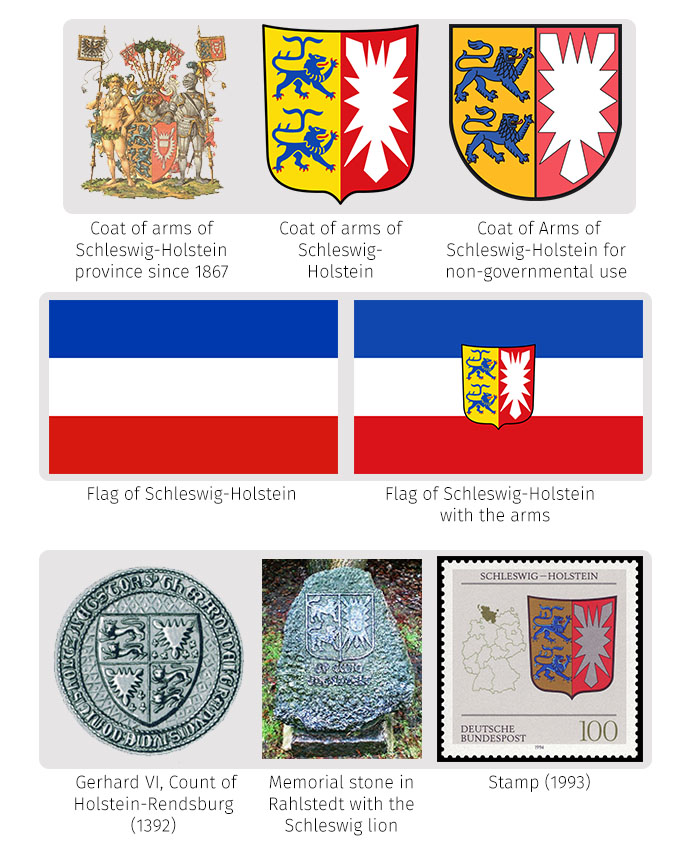
Symbols of Schleswig-Holstein
The flag of Schleswig-Holstein is mentioned in the movement for withdrawal of the land from Denmark. For the first time the flag of Schleswig-Holstein was introduced in 1843. It was also used during the existence of the eponymous province in Prussia. The coat of arms of the state is quite ancient, that may indicate a print of the 1392 year and a stone in Rahlstedt in which this coat of arms was forged.
Also, I advise you to get acquainted with this ancient painting of 1341:
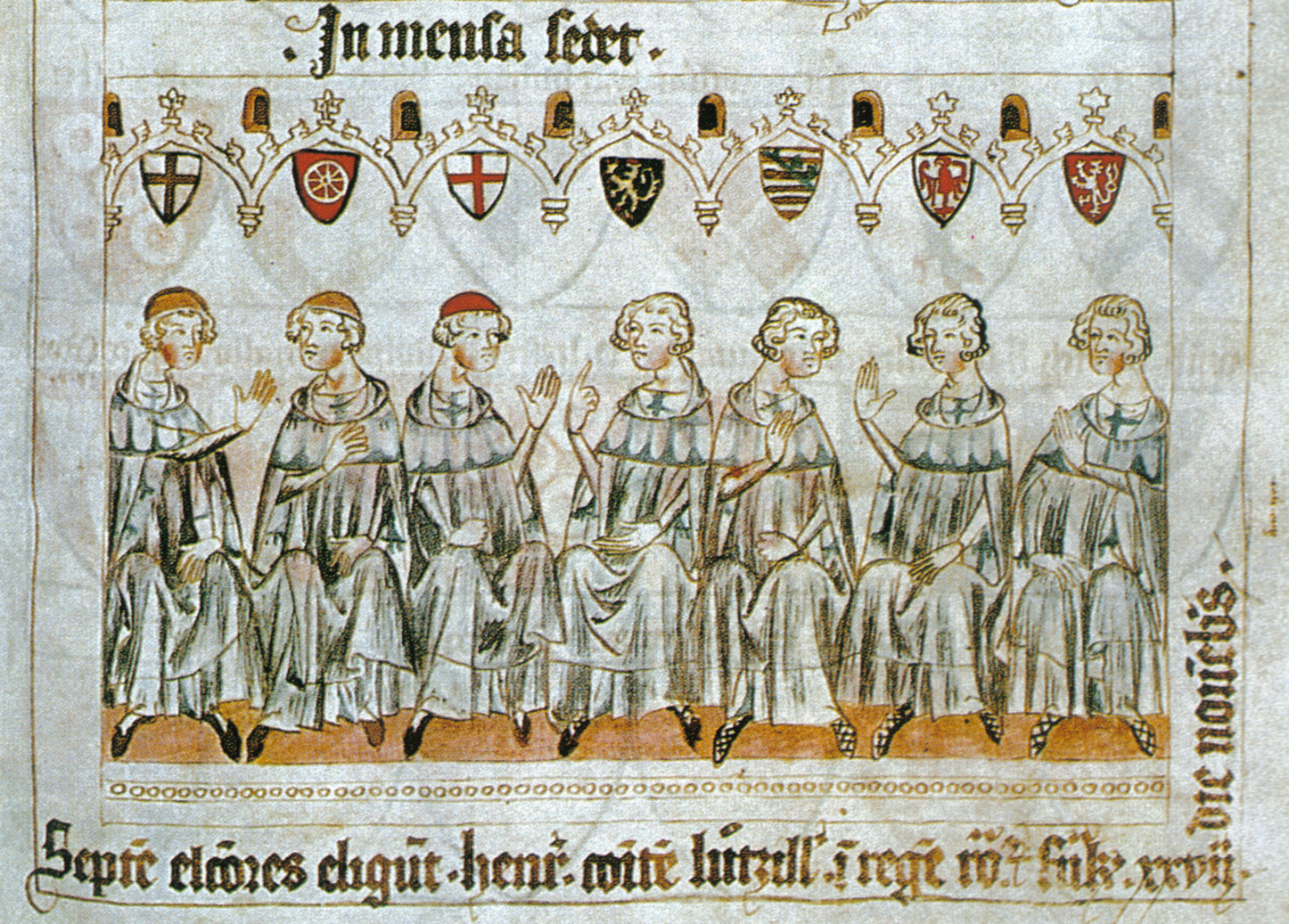
The rulers of the seven electors with the coat of arms of their ancestral lands, from left to right: the Archbishops of Cologne, Mainz and Trier, Count Palatine of the Rhine, Duke of Saxony, Margrave of Brandenburg and King of Bohemia
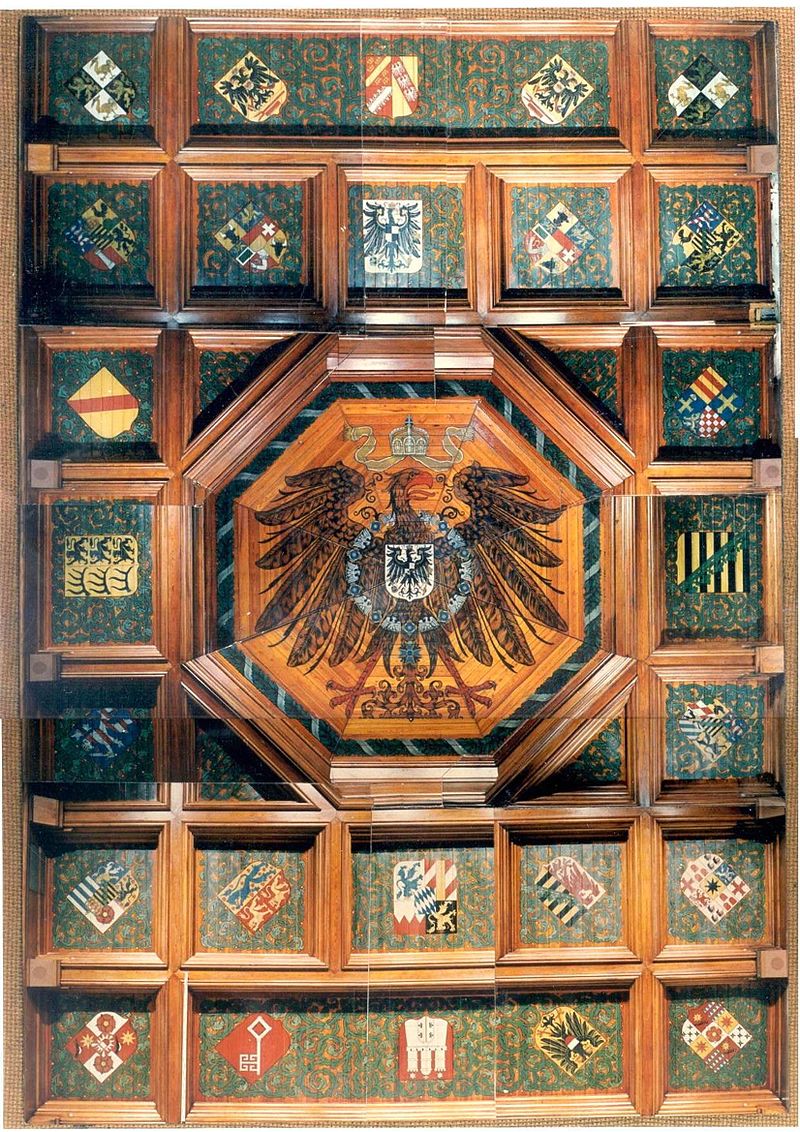
Ceiling in the Naval Academy at Mürwik
Let’s now divide the flags of the states by their structure.
Horizontal Bicolors
There are six bicolor flags in this group. Three of them can be confused with the flag of Poland, Monaco or Indonesia.

Horizontal bicolors
Horizontal Tricolors
We’ll put an exactly the same number of flags in this group. The colors of the current flag of Germany that strongly resemble the flags of Lower Saxony, Saarland and Rhineland-Palatinate have been already in use in the Middle Ages. Later, these colors were used by the Jena student union and then the flag started to symbolize the struggle for freedom and the unification of the whole Germany; and so the black color began to symbolize a dark night, red — blood in the struggle and gold — the color of the Sun.
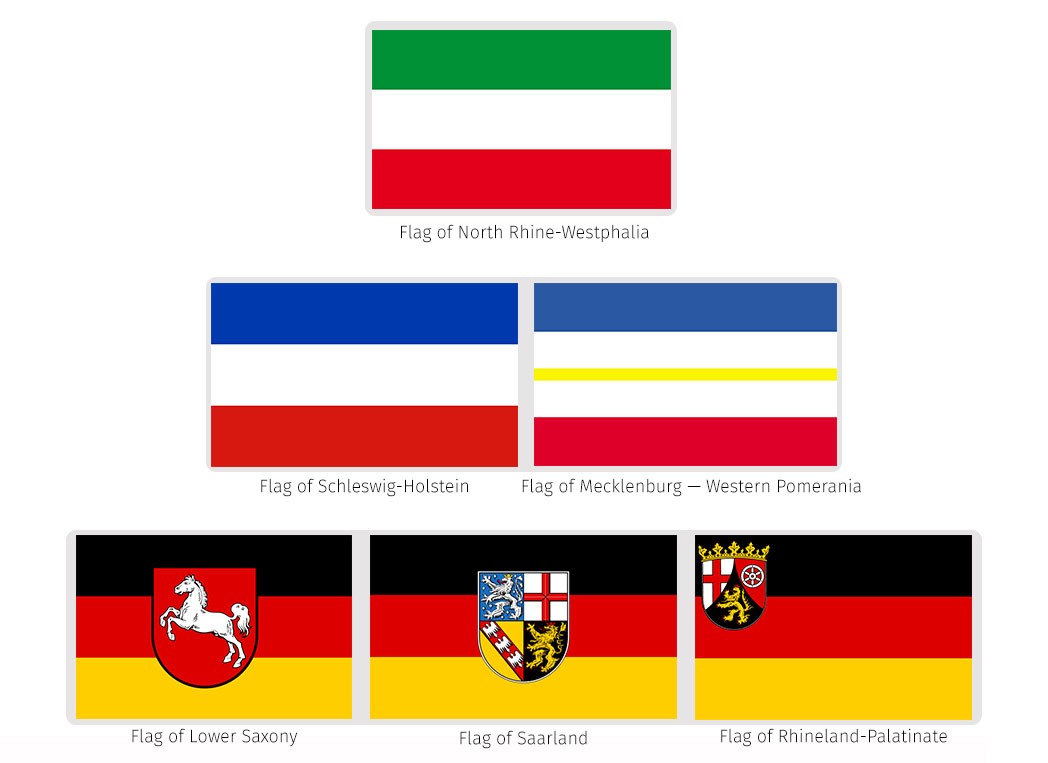
Horizontal tricolors
Other
The last group of German flags includes four remaining territories. Among them: the federal state of Bavaria and three city-states — Hamburg, Bremen and the capital of Germany — Berlin.
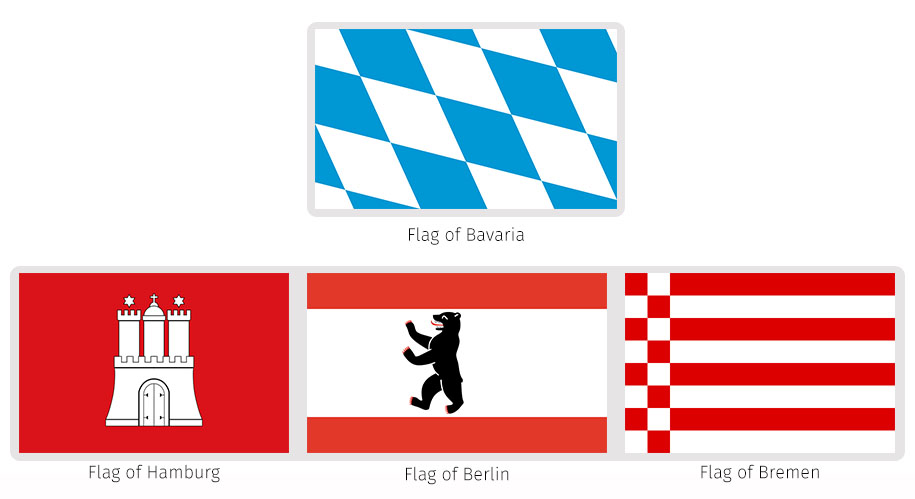
Other
Thus, we derive a map of Germany based on the flag type.
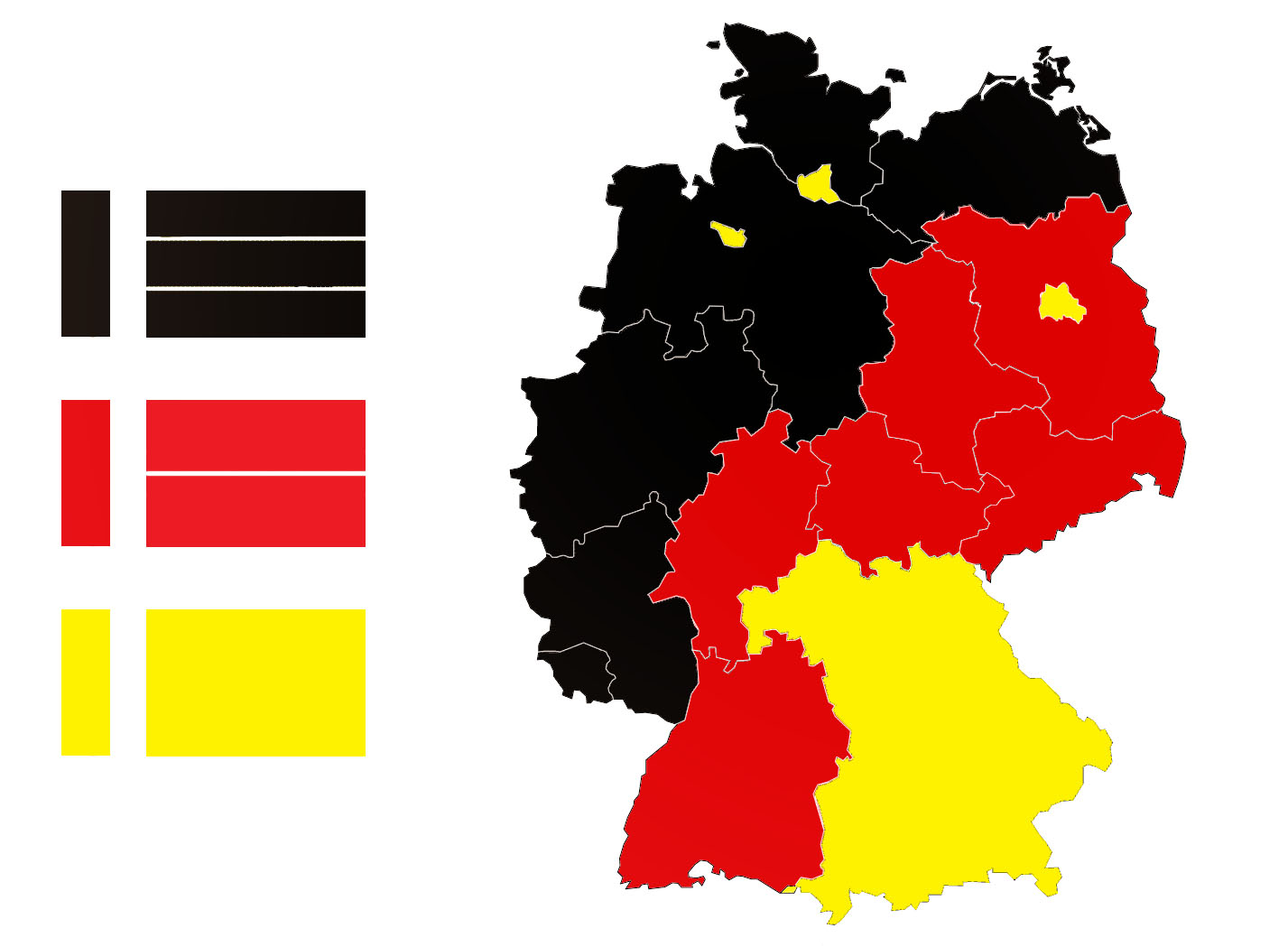
Black — tricolors, red — bicolors, yellow — other
It is also interesting to take a look at the map of colors used on these flags. Let’s segment the flags in terms of their major colors:

Flags of Germany and their colors
It is now possible to make a map of the most commonly used colors in certain parts of Germany:

Map of German states based on their flag colors
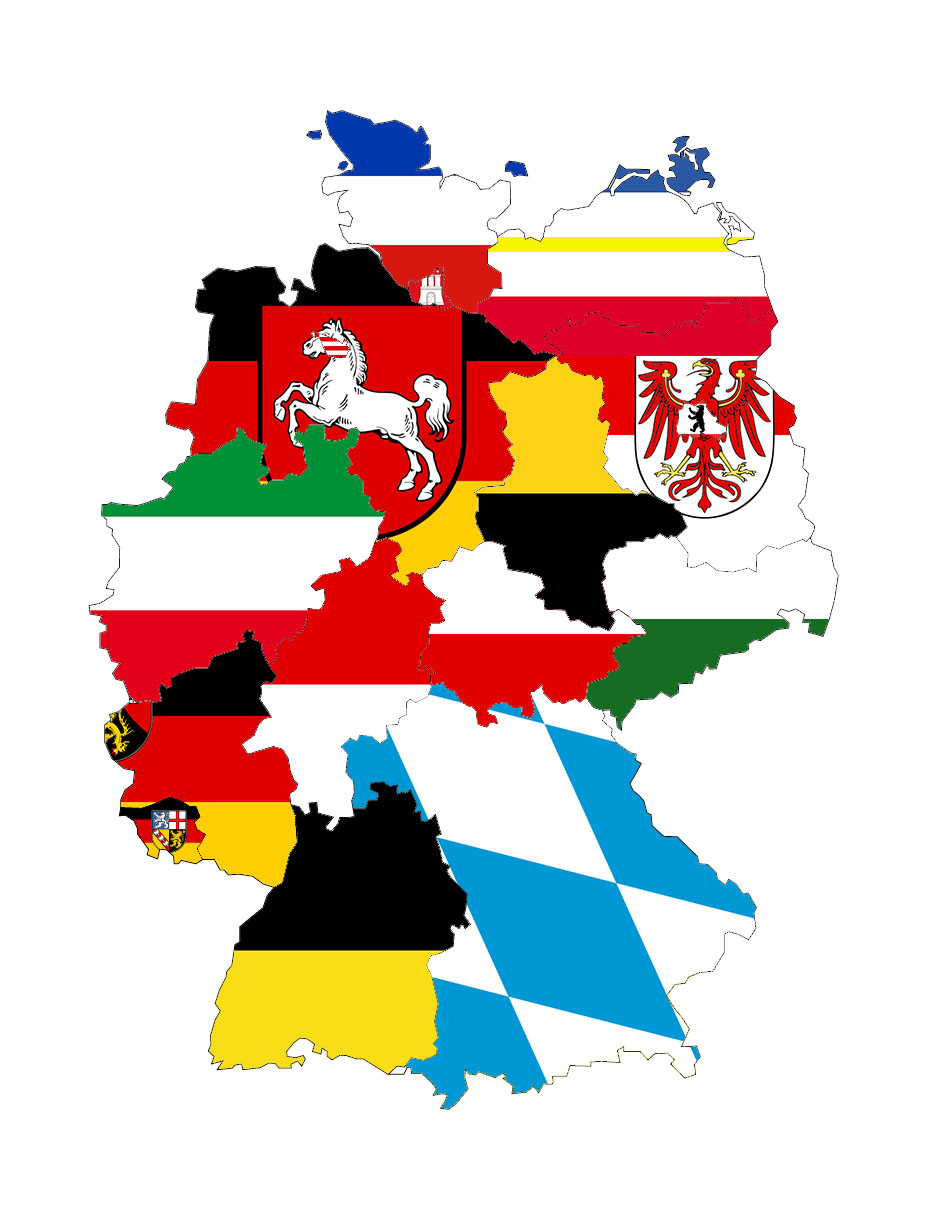
Map of Germany filled with the flags of the states
Coat of Arms of Germany
We shall do the same thing with the coat of arms of the different German states, which are in turn an equally interesting symbol of every administrative unit of the country.
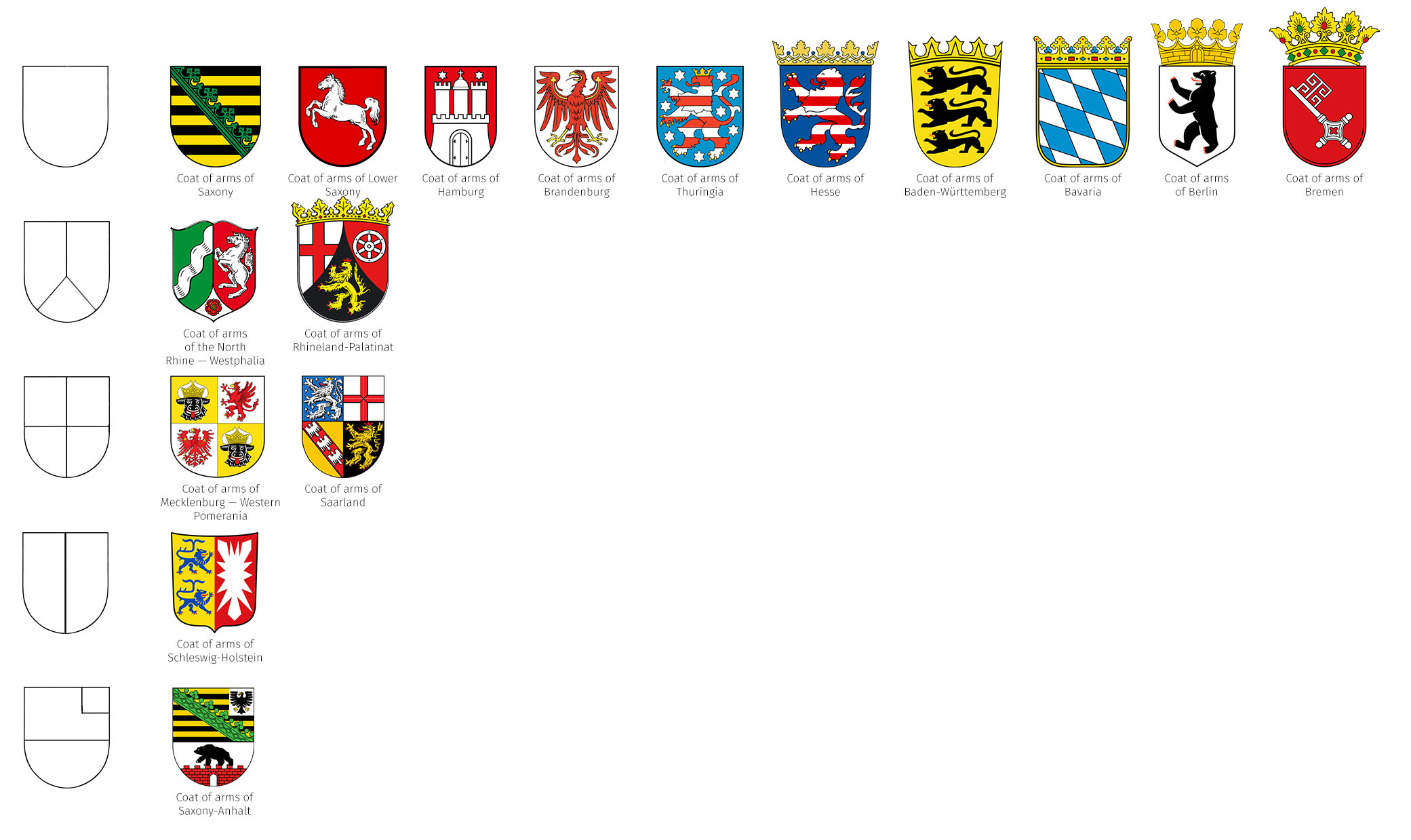
Coat of arms of Germany based on their structure
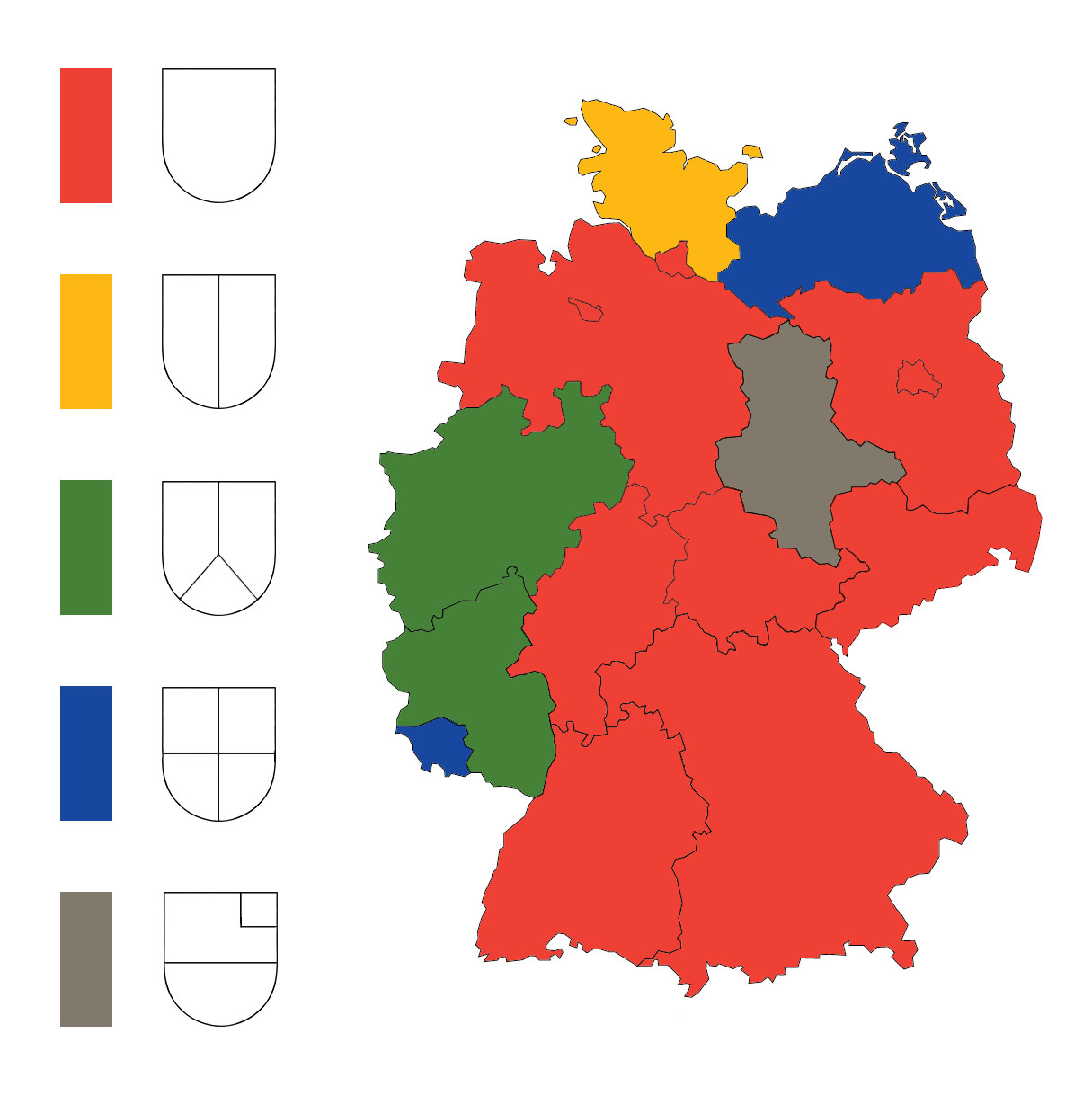
Map of Germany based on the structure of the coat of arms

Map of Germany filled with the coat of arms



























Comments